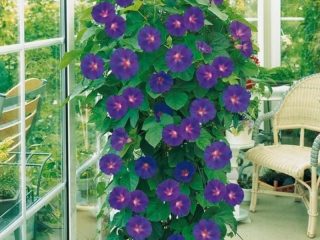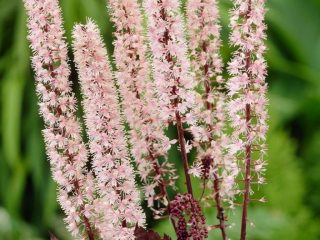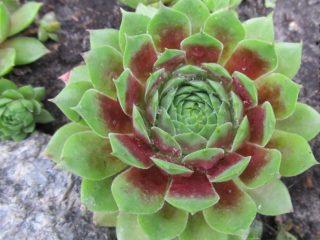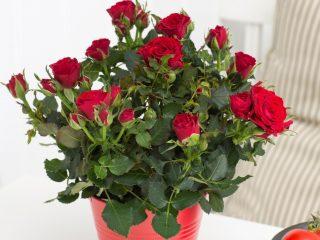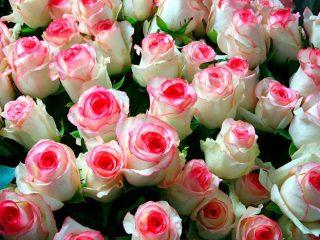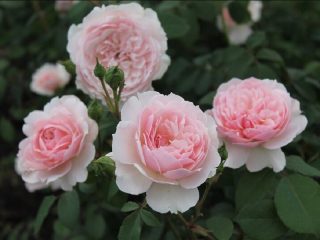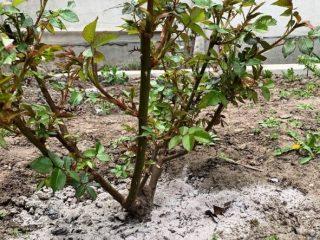Content
Rose Freesia (Friesia) is a beautiful, profusely flowering, perennial shrub. Its bright yellow buds, which can be seen throughout the summer, attract the admiring glances of all flower lovers. Freesia rose bushes are compact and fit perfectly into the landscape design of flower beds made in any style. Cut flowers are often used by florists to make bouquets.
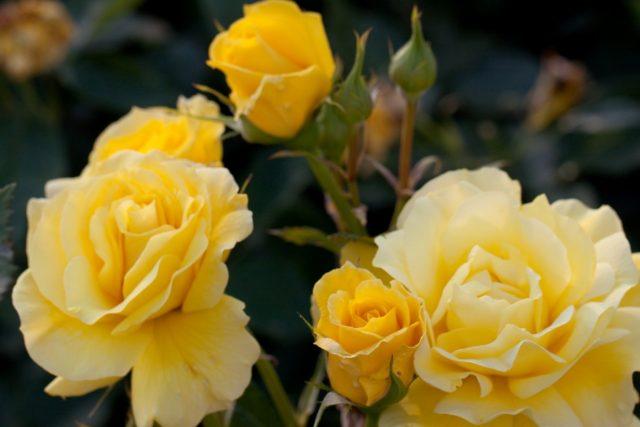
The Freesia rose variety belongs to the floribunda group, which is popular in the world.
History of selection
The freesia bush rose appeared thanks to the work of breeders from Germany. It was bred quite a long time ago, more than forty years ago, in 1977. The authors of the Freesia variety are specialists from the Kordes company, who obtained the rose by grafting onto an ordinary rose hip.
Description of the Freesia rose variety
Polyantha rose Freesia is a small, well-leafed bush with a tree-like trunk and branching shoots that are well suited for creating a living fence. The plant usually grows up to 80 cm in height (maximum 1 m), and in width it does not exceed 70 cm.The leaf blades of the crop are thin, round in shape with a slightly jagged, pointed tip. Their color is green, rich, the surface is glossy and shiny, with a clearly visible central vein. The root system of the rose is powerful and well developed. Freesia buds are densely double, have a yellow, less often lemon color, which is darker on the back side, their aroma is subtle fruity, their shape is cup-shaped, each inflorescence is racemose, with up to eight flowers. The size of the buds is large, in diameter they can reach 10 cm. They bloom quickly and fall off already on the fifth to seventh day. The floribunda variety Freesia is a re-blooming rose, the flowering of the rose begins in June and continues until October, although the time interval between each stage is significant.
The variety is unpretentious in terms of care and growing conditions. It is characterized by high resistance to winter (frost resistance zone 5), easily tolerates temperatures down to -29 ° C, and easily copes with returning spring frosts. Freesia is a variety that is not susceptible to precipitation, but in bright sun the buds of the variety are susceptible to fading.
Freesia is rarely susceptible to disease. Its bushes are highly resistant to powdery mildew and black spot. The plant develops equally well in the shade and in the sun, is not particularly demanding on the composition of the soil and can be grown even on poor soil.
Freesia roses can be used to decorate any flower bed; it fits perfectly into a variety of landscape compositions.
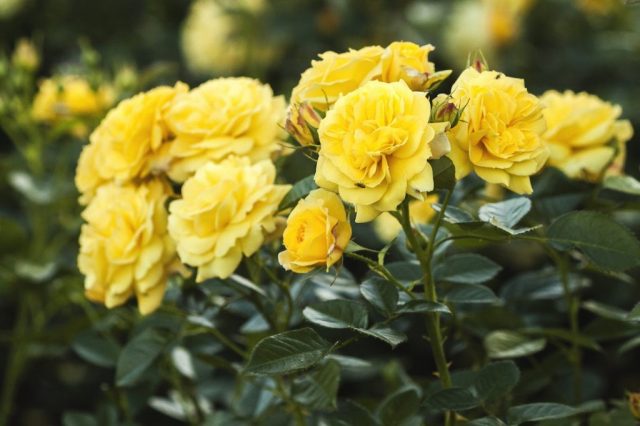
Among summer residents, this variety is considered the most popular
Advantages and disadvantages
Rose Freesia has earned great love from flower growers and has an impressive list of advantages, compared to minor disadvantages.
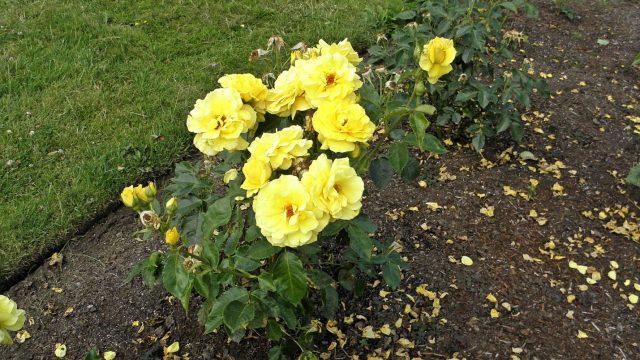
The variety is considered an example of high-profile selection of roses on a standard
Advantages:
- long and abundant flowering;
- large bud size;
- high winter hardiness;
- suitability for cultivation in regions with short summers;
- resistance to many diseases;
- bright colors;
- unpretentiousness to growing conditions;
- immunity to rain;
- pleasant aroma of flowers.
Flaws:
- rapid shedding of buds;
- demands on the intensity of irrigation;
- possible sunburn;
- long interval between initial and repeated flowering.
Recommendations for cultivation
Despite the fact that Freesia is considered an unpretentious rose, in order to see all the beauty of its flowering, it is necessary to follow the rules that apply to its planting and cultivation. The variety prefers slightly shaded or sunny areas with any soil, but it is better if it is fertilized black soil or loam. The place should be well ventilated, but it should not be located in a low area where cold air accumulates. The groundwater level where it is planned to plant Freesia bushes should be no closer than one and a half meters, otherwise the plant will be susceptible to black spotting. Ideally, if the soil is loose, with a neutral or slightly alkaline reaction.
The crop can be planted in spring or autumn in deep (half a meter) holes with a ten-centimeter drainage layer laid on the bottom. It is advisable to first keep the roots of the bush in a nutrient mixture.
As for care, the Freesia rose needs frequent and abundant watering with warm, settled water, especially in hot weather. It needs constant loosening and mulching with wood shavings or manure. It is advisable to apply nitrogen fertilizers; watering with saltpeter, mullein, and urea is useful; before winter, it is good to apply fertilizers containing phosphorus and potassium under the bushes. In spring and summer, the shrub is subjected to sanitary and formative pruning, the shoots are shortened by 10-15 cm. Throughout the entire flowering period, fading Freesia buds are cut off so that new flowers appear faster. With the arrival of late autumn, roses growing in northern latitudes and the middle zone are covered. Why, after shortening them twice, the bushes are hilled up, then covered with spruce branches and special material on top.
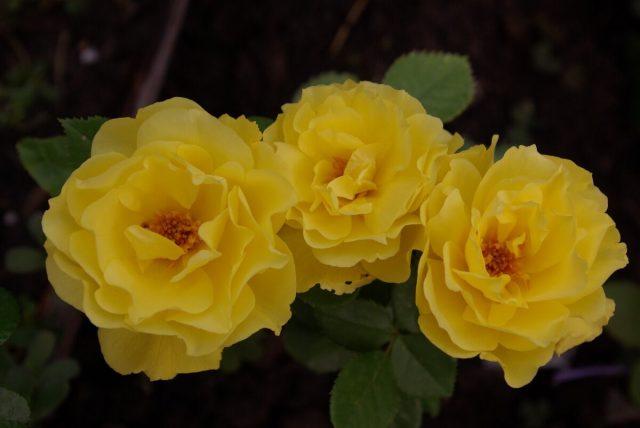
In the UK, the Freesia variety was awarded the James Mason Medal for its particular popularity.
Reproduction methods
Yellow rose floribunda Freesia reproduces by corms and tuber buds. In the first case, the procedure is easy to perform. You need to dig up an adult bush of the plant, separate its bulbs from each other and plant them in pre-prepared holes. In the second case, the process is more labor-intensive, and its implementation does not always bring a positive result. It involves sowing the seeds of the crop in the spring, and propagation itself in the fall, in September.
In March, rose planting material is placed on top of a mixture of sand and peat, in shallow containers. After this, lightly cover it with soil and moisten it.With regular watering and suitable conditions, Freesia sprouts appear in about a month, when they reach a height of 3 cm, they are thinned out. After planting in the holes, the tubers are sprinkled with humus and provided with further care.
Diseases and pests
The Freesia rose variety is resistant to powdery mildew, black spot, and some viruses. With good care, they are practically not affected by them at all. It has average immunity to fusarium, chlorosis and scab, which requires preventive measures to prevent their development.
Among the insect pests, freesia rose bushes can be attacked by aphids, cicadas, and spider mites. To prevent this, you should regularly inspect the plants for the presence of parasites and, if necessary, spray the plantings with insecticides.
Application in landscape design
Floribunda Freesia is a rose that can be seen from afar during flowering. It is very bright and beautiful, has excellent decorative properties, and is perfect for decorating flower beds, gardens and personal plots. It is often planted in front of the house, in places where the bush will be visible from different sides. In small areas, the variety is used to create ridges. Rose Freesia looks beautiful in mixed borders, is suitable for planting in borders, and can be used as a hedge. It goes well with almost all flowers and shrubs, but it is best to combine it with more modest crops so that against their background it reveals its beauty to the fullest.
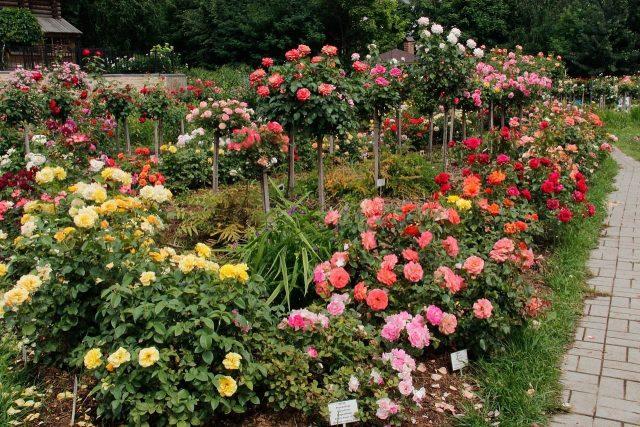
Due to the yellow buds, the variety stands out against the background of other ornamental crops.
Conclusion
Rose Freesia, subject to agrotechnical rules for care and cultivation, pleases flower growers with its attractive flowering for a long time. It is not difficult to monitor it; the main thing is to follow the recommendations of experienced gardeners. The shrub needs special attention during the period of active flowering.
Reviews of rose Freesia
